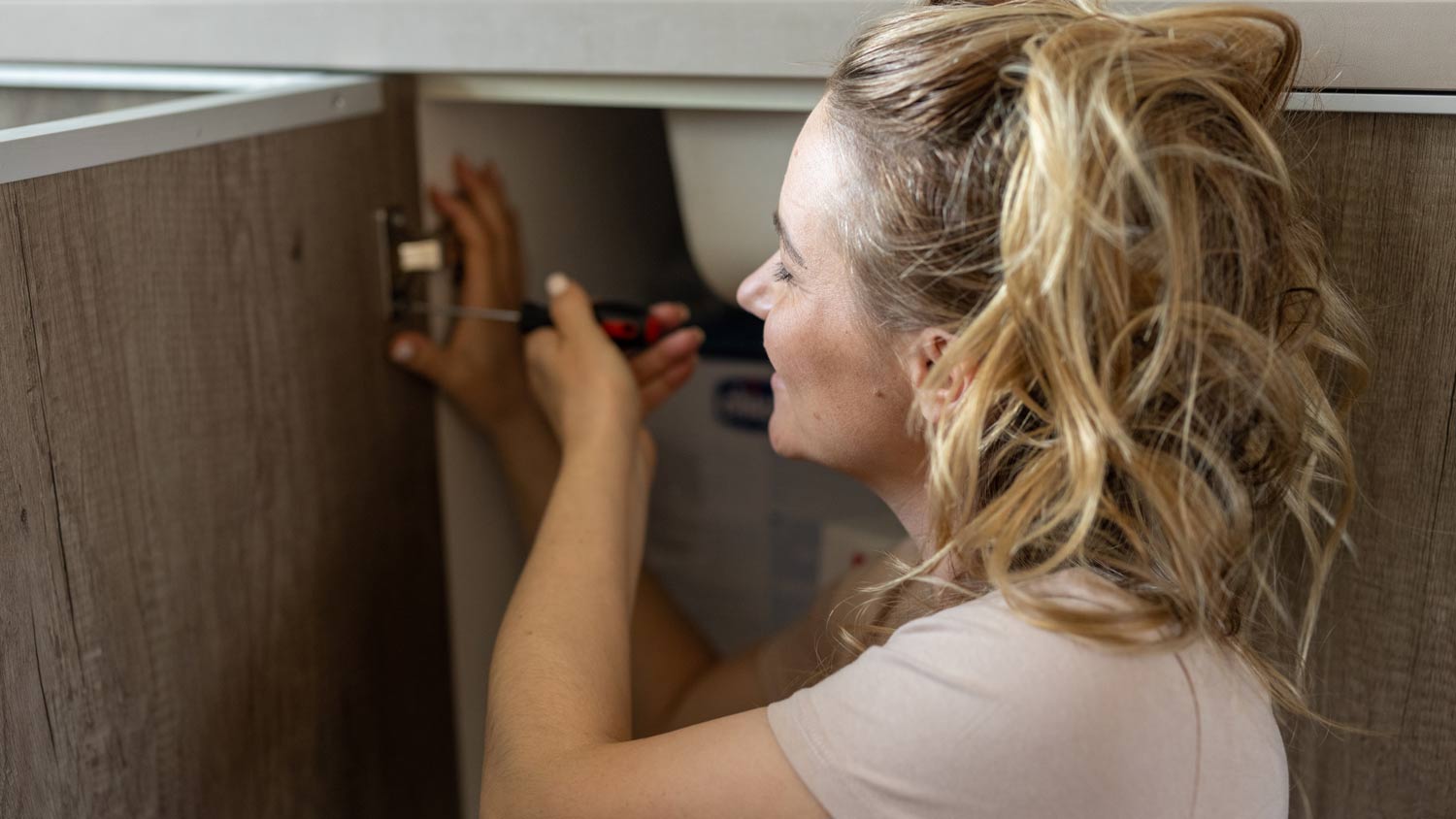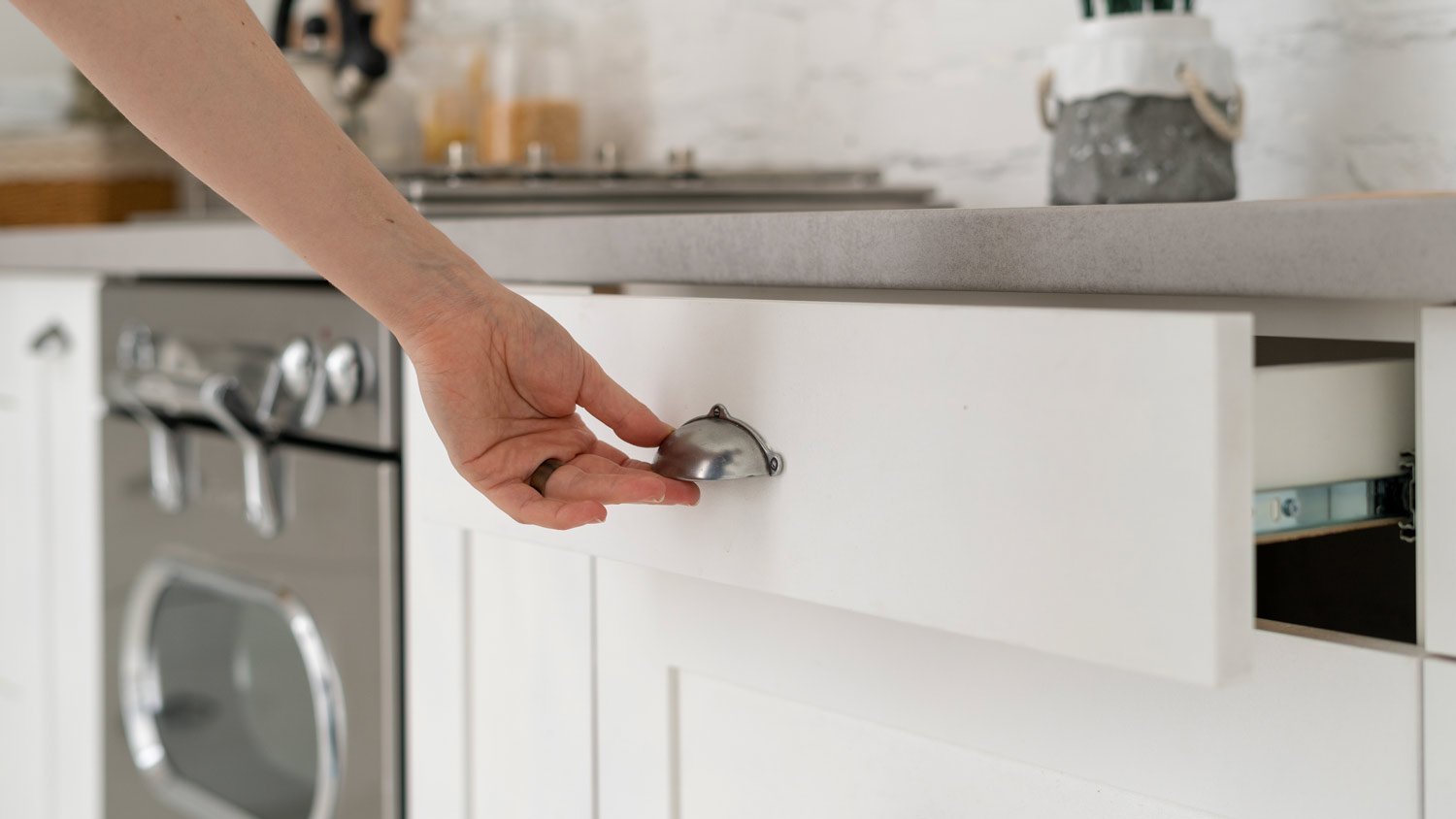5 Common Problems With Refacing Kitchen Cabinets
You can face the challenges of cabinet remodeling


Cabinet refacing can be cheaper than a full replacement.
Nearly any type of cabinet can be refaced, especially wood or MDF.
Most refacing mistakes are avoidable.
Professional cabinet refacing minimizes the risk of problems.
Refacing kitchen cabinets is an excellent way to upgrade your kitchen while minimizing remodeling costs. The project is a big one, though. And while refacing cabinets can save money over replacing them, there are other pros and cons to consider before diving into the project.
Problems with refacing kitchen cabinets are common. However, all of them are avoidable with a little planning and research. Here are the five most common issues homeowners run into before, during, and after the project and how to avoid them.
What Is Cabinet Refacing?
Cabinet refacing updates your kitchen cabinets by covering existing doors, drawer fronts, and cabinet frames with a new veneer. Refacing is possible with nearly any type of cabinet. However, refacing sturdy wood or medium-density fiberboard (MDF) construction cabinets will yield the best results.
With cabinet refacing, your cabinets retain the same layout and overall functionality—only the aesthetic changes. Homeowners often change colors, wood species, or pattern designs to upgrade their cabinets to enhance the beauty of their kitchens.
Common Problems With Refacing Kitchen Cabinets
Refacing kitchen cabinets is a straightforward but tedious task. To complete the project in the quickest and easiest manner, it’s worth knowing and avoiding these five common issues.
1. Color Matching Issues
When refacing kitchen cabinets, you're not replacing the entire cabinets—the only parts getting a facelift are the parts the new veneer will cover up. What this means is that, sometimes, a homeowner will discover an unintentional error later, such as a noticeable color change in a gap where the stove meets the base cabinets that didn’t get covered with veneer. This issue is more prevalent when making a distinct color or pattern change with the veneer.
There's really just one way to avoid the problem of color-matching issues, and that's to be sure to reface all surfaces that could possibly be visible. Doing so takes some planning. You'll likely have to move appliances like the refrigerator or stove to complete the project. Consider hiring a nearby gas plumber to disconnect a gas stove if necessary.
2. Doors and Drawers That Stop Working

Kitchen cabinets are often used to hide appliances, and they frequently have tight tolerances between doors, drawers, or hinges. Adding a veneer slightly changes the dimensions of your cabinets, doors, and drawers and can cause operational issues. Doors and drawers that become too close together may no longer open and close properly. Hardware and hinges that used to fit may no longer have the space to function correctly.
Avoiding operational problems due to slight size increases is difficult to overcome for cabinets that have tight spaces between doors and drawers. It's possible to shave the doors and drawers down before veneering. However, that can lead to mistakes and several other aesthetic problems.
The best way to avoid operational problems is to measure carefully before starting work and determine that the functionality won't be affected by adding a small amount of material. You may also need to make slight adjustments when rehanging doors and installing drawers. Consider replacing old hinges and hardware with adjustable models that suit the situation.
3. Dealing With Cabinet Damage
Putting a veneer over cabinets that have water or other damage takes special skill and patience. While hiding cabinet damage with veneer is possible, doing so requires plenty of preparation. Many homeowners simply choose to replace single cabinets with new ones to avoid attempting the fix. If you're dealing with a large amount of damage, replacing the cabinets is generally better than trying to repair them by refacing them.
To deal with isolated cabinet damage, first remove any rotten surfaces and treat whatever problem is there to eliminate it. Next, repair the wood or MDF with an appropriate filler or epoxy before adhering the new veneer to the surface. A local cabinet refacing company can offer solutions in this or any other cabinet situation.
4. Underestimating the Costs
Although refacing cabinets is usually more affordable than a full replacement, this is still a big job that requires a lot of planning. It's easy to underestimate the project and the cost of cabinet refacing, but the reality is that refacing kitchen cabinets can easily end up costing several thousand dollars. Avoid going over budget by learning all you can about the steps involved, knowing what mistakes to look out for, and mitigating them before the work starts.
5. Being Too Trendy

Finally, before starting and spending a bunch of money on the latest trendy cabinet refacing fad, remember that cabinet refacing is difficult to reverse once complete. Stay alert against updating your kitchen to the latest trend, only to find out soon after that the style is just a passing fad.
When and however you remodel any room in your home, remember that trends come and go, but simpler and more classic designs can adjust to the times with a few minor tweaks rather than large overhauls, providing a longer, happier lifespan.
Kitchen Cabinet Refacing Costs
If you want to update your kitchen cabinets and save money in the process, refacing them is cheaper than replacing them. You can expect refacing to cost 30% to 50% of what a total cabinet replacement would cost. Despite that, refacing is a fairly expensive undertaking in itself. It costs between $1,800 and $5,000 on average, and some projects can cost up to $10,550 depending on the materials used and number of cabinets involved. Larger kitchens are naturally pricier, as it costs anywhere from $30 to $100 per cabinet door. That doesn’t include expenses for tools if you do it yourself or labor if you hire a pro.
DIY vs. Hiring a Pro
Cabinet refacing is a moderately challenging DIY project. Most homeowners can do it themselves, but it requires patience and access to specialized tools and supplies, like a laminate slitter and miter saw. If you’re up for the task, it’s cheaper than hiring a local cabinet refinishing contractor, especially since the job can take a few days to complete.
There are advantages to hiring a pro, though. It guarantees the job will be done correctly and that you’ll get the desired results. Additionally, hiring a pro saves time and the hassle of renting or purchasing the necessary tools. The decision to DIY or hire a pro comes down to your budget, handiness, and willingness to tackle a time-consuming project.
Deane Biermeier contributed to this piece.
Frequently Asked Questions
Refaced cabinets should last for 10 to 20 years and possibly even longer. The process holds up better than simpler refinishing methods like painting or glazing, which is why it’s a popular, albeit costly, option. In fact, refaced cabinets last roughly as long as brand-new ones. The difference is that new cabinets can last up to 50 years if they are exceptionally high-quality. Proper maintenance, like regular cleaning and avoidance of harsh products and water damage, can increase the lifespan of your kitchen cabinets, no matter if they are new, refaced, or refinished.
Whether to reface or paint comes down to personal preference. Refacing strikes a convenient balance between being more affordable than replacing cabinets and longer-lasting than painting them. Furthermore, it allows homeowners to completely change the aesthetic of their cabinets and still paint them if they choose to. If money was no object, refacing is the better option. However, it’s more expensive and time-consuming than painting. Painting remains an effective way to revamp your cabinets, both in look and longevity, without spending a ton of money.
While refacing is an overall improvement to your kitchen cabinets, it has a few trade-offs. Most notably, refacing tends to be expensive, averaging around $4,500. That’s significantly more than the cost of staining or repainting cabinets. It’s also more time-consuming than painting. Another downside is that it doesn’t allow for significant structural changes if you’re looking to alter the layout of your kitchen. Finally, refacing is not viable if your cabinets are severely damaged. In that instance, you likely need to replace them.





- Cabinet Refacing vs. Refinishing: What Is the Difference?
- The Pros and Cons of Painting Kitchen Cabinets
- How To Build Cabinets: 9 Steps to Follow
- Should You Paint Your Cabinets White? Here Are the Pros and Cons.
- How to Clean Kitchen Cabinets With Ease
- How To Install Kitchen Cabinets: 10 Steps to Success
- 10 Foundation Refacing Tips to Boost Your Curb Appeal
- Who Do I Hire to Paint Kitchen Cabinets?
- How to Paint Kitchen Cabinets: A Complete Guide
- Can You Steam Clean Kitchen Cabinets? Tips for Safe Steam Cleaning

 - Derek Rose.png?impolicy=thumbnail)








